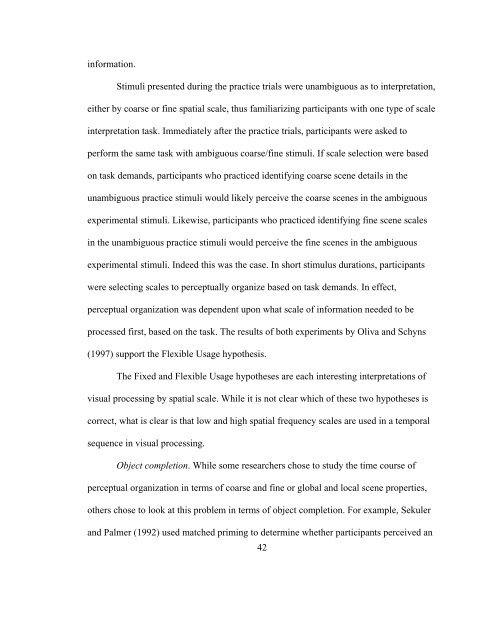The Use of Iambic Pentameter in the
The Use of Iambic Pentameter in the
The Use of Iambic Pentameter in the
Create successful ePaper yourself
Turn your PDF publications into a flip-book with our unique Google optimized e-Paper software.
<strong>in</strong>formation.<br />
Stimuli presented dur<strong>in</strong>g <strong>the</strong> practice trials were unambiguous as to <strong>in</strong>terpretation,<br />
ei<strong>the</strong>r by coarse or f<strong>in</strong>e spatial scale, thus familiariz<strong>in</strong>g participants with one type <strong>of</strong> scale<br />
<strong>in</strong>terpretation task. Immediately after <strong>the</strong> practice trials, participants were asked to<br />
perform <strong>the</strong> same task with ambiguous coarse/f<strong>in</strong>e stimuli. If scale selection were based<br />
on task demands, participants who practiced identify<strong>in</strong>g coarse scene details <strong>in</strong> <strong>the</strong><br />
unambiguous practice stimuli would likely perceive <strong>the</strong> coarse scenes <strong>in</strong> <strong>the</strong> ambiguous<br />
experimental stimuli. Likewise, participants who practiced identify<strong>in</strong>g f<strong>in</strong>e scene scales<br />
<strong>in</strong> <strong>the</strong> unambiguous practice stimuli would perceive <strong>the</strong> f<strong>in</strong>e scenes <strong>in</strong> <strong>the</strong> ambiguous<br />
experimental stimuli. Indeed this was <strong>the</strong> case. In short stimulus durations, participants<br />
were select<strong>in</strong>g scales to perceptually organize based on task demands. In effect,<br />
perceptual organization was dependent upon what scale <strong>of</strong> <strong>in</strong>formation needed to be<br />
processed first, based on <strong>the</strong> task. <strong>The</strong> results <strong>of</strong> both experiments by Oliva and Schyns<br />
(1997) support <strong>the</strong> Flexible Usage hypo<strong>the</strong>sis.<br />
<strong>The</strong> Fixed and Flexible Usage hypo<strong>the</strong>ses are each <strong>in</strong>terest<strong>in</strong>g <strong>in</strong>terpretations <strong>of</strong><br />
visual process<strong>in</strong>g by spatial scale. While it is not clear which <strong>of</strong> <strong>the</strong>se two hypo<strong>the</strong>ses is<br />
correct, what is clear is that low and high spatial frequency scales are used <strong>in</strong> a temporal<br />
sequence <strong>in</strong> visual process<strong>in</strong>g.<br />
Object completion. While some researchers chose to study <strong>the</strong> time course <strong>of</strong><br />
perceptual organization <strong>in</strong> terms <strong>of</strong> coarse and f<strong>in</strong>e or global and local scene properties,<br />
o<strong>the</strong>rs chose to look at this problem <strong>in</strong> terms <strong>of</strong> object completion. For example, Sekuler<br />
and Palmer (1992) used matched prim<strong>in</strong>g to determ<strong>in</strong>e whe<strong>the</strong>r participants perceived an<br />
42

















